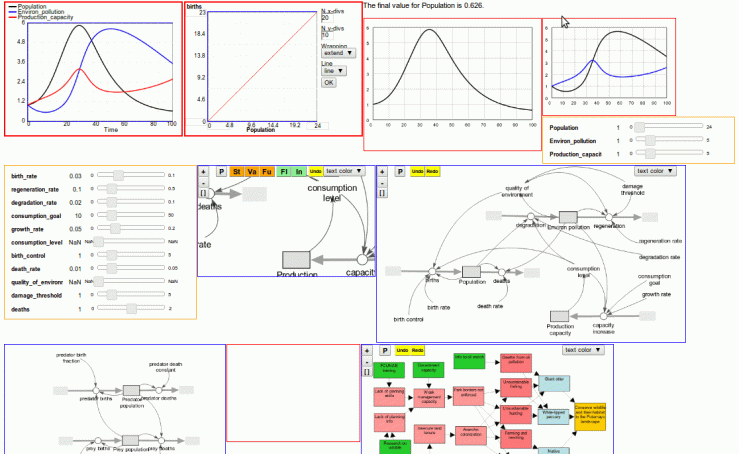Systo is an open, adaptable and lightweight approach for viewing, building and running systems models in web pages.
At its core, Systo allows anyone with minimal knowledge of HTML and Javascript to build a web page for viewing, building and simulating the behaviour of simulation models.
The key underlying concept is that a web page is assembled from a set of widgets. Each widget handles one aspect of working with models:; for example:
– displaying the model diagram;
– displaying a graph of simulation results;
– listing the model equations.
The following screendump illustrates the approach with a sample of widgets from a Systo-based webpage.
The way that web page developers do this is very similar to the way that they include images in a web page, but inserting <div> rather than <img> elements at the appropriate place. Then, instead of linking to something static (the image), the element is linked to the widget which performs the appropriate task (such as plotting a graph) – this can be done with a single line of Javascript. The widgets themselves can live anywhere on the web: one page can pull in widgets from a variety of URLs (just like one could do with images).
This approach is in marked contrast with almost all web apps, which provide a single, monolithic, “walled garden” web site: a single URL (such as http://www.facebook.com) which totally controls how you can work. With Systo, there can be 100s of Systo-based web sites, each reflecting web-page design choices made by the web-page developer.
Moreover, anyone with the ability to program in Javascript can make their own widgets – either by modifying an existing one or by creating a new one from scratch. Some of these could be improvements on exiting ones; others could implement some great innovative idea about how to work with models.
Together, these characteristics of Systo promise to unleash a great burst of creativity in the way we model. Web page developers will design really engaging web pages, perhaps incorporating audio, video, graphics and images to go along with model diagrams and display of results. Anyone interested in improving the way we work with models just has to make a single widget, piggy-backing on pre-exiting components for handling other aspects of the modelling process, rather than having to develop heir own modelling environment from scratch.
This blog starts as Systo cautiously approaches its initial release. I will be reporting on developments, and ruminating on some of the issues faced while working on it. Hopefully, others will join in – if only to suggest better ways of doing things!
